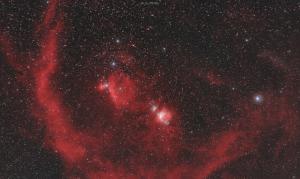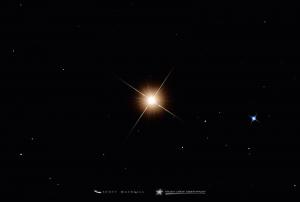Celebration of Space - May 27, 2022

The 2018 Geminid Meteor Shower at Frosty Drew Observatory and Science Center. Credit: Frosty Drew Astronomy Team member, Scott MacNeill.
Overnight, Monday – Tuesday, May 30-31, 2022, a special meteor shower may occur, and with it could come dozens of meteors per second. The shower is the Tau Herculid Meteor Shower, and the cause of the shower is the comet 73P/Schwassmann-Wachmann 3 (SW3), which was discovered in 1930. It is a periodic comet that has an orbital period of 5.4 years around the Sun. Well in the year 1995, comet SW3 fractured into four segments, and during that year became briefly visible to the naked eye. Of the four parts, two of them disintegrated into debris, with the other two remaining intact. In the year 2006, observations of comet SW3 showed that the two remaining fragments had continued to fragment, resulting in 68 comet fragments. The comet continues to fragment further to this day. The debris from the 1995 break up is what may interact with Earth’s atmosphere this coming Tuesday. Now there are a lot of “ifs” involved in this meteor display, and the probability that we will actually see something is rather small. The debris from the 1995 fragmentation would have to have been expelled at greater than 220 miles per hour. If so, that could put the debris field into a path that will intersect Earth’s orbit this year.
Observing the potential meteor shower will require a location with dark sky conditions. So get out of the city! Timings of the meteor shower are questionable, but generally expected around 1:00 am ET on Tuesday morning. If heading out, be at your destination for 11:00 pm, and plan to stick around until 3:00 am for the best window of opportunity. The shower will radiate from a point in between the constellations Hercules and Bootes (here is a star chart). Lay on your back either on a blanket or lawn chair with your feet orientated towards the south, and look to the zenith (top of the sky). With a little luck, you just may catch a huge display of shooting stars.
Over the holiday weekend and into next week, evening passes of the International Space Station (ISS) will continue, eventually ending on June 3, 2022 with a rather uneventful pass. Due to the ISS orbiting Earth inclined 51º to the equator, the station is not always in the same location as it passes overhead. To see the station, or any satellite, the observer needs to be at a location where the Sun has set, but the satellite is still in direct sunlight. Even though we are fast approaching the Summer Solstice, which is when we have the best chance of catching a visible pass of satellites over the entire nighttime period, the ISS will be orbiting over the Southern Hemisphere during all nighttime passes until the morning of June 24, 2022, when it will return to our morning predawn sky. Here are a few notable passes to celebrate over the coming nights:
Fri, May 27 at 10:02 pm, starting in the NW, rising to 51º, heading towards the east and into orbital sunset.
Sat, May 28 at 9:14 pm, starting in the NW, rising to 34º, heading towards the east and into orbital sunset
Sun, May 29 at 10:03 pm, starting in the WNW, rising to 57º, and into orbital sunset
Mon, May 30 at 9:15 pm, starting in the NW, rising to 82º, heading towards the ESE and into orbital sunset ← Awesome pass!
Tue, May 31 at 10:03 pm, starting in the west, rising to 20º, and into orbital sunset
Wed, Jun 1 at 9:15 pm, starting in the WNW, rising to 34º, heading towards the SSE and into orbital sunset.
Note that these times are applicable to Southern New England, and are generally acceptable for the entire Northeast. For daily pass times of the ISS and other bright satellites, visit the Frosty Drew Daily Satellite Prediction Utility. Now put these times on your calendar and step outside for a view of humanity’s only continuously inhabited space-based residency zooming by.
Those who have been enjoying the clear sky moments lately, have probably noticed that the constellations, and stars visible this time of year appear to advance very quickly, with the springtime and winter constellations moving out to make way for summertime celestial goodness. Does the sky advance faster in the spring than it does in the winter? At first glance it would appear so, but you have to take into account the time of sunset and how that is changing as well. The motion of the sky, from east to west, is not a product of the sky moving (stars, planets, etc), but instead is a product of Earth spinning on its axis (our 24 hour day). The yearly movement of the constellations is, again, not due to the sky moving, but Earth’s motion around the Sun. Think of it this way: A constellation that may be due south at midnight on the Winter Solstice, will also be due south at noon on the Summer Solstice. This is because the constellations are fixed, and as Earth orbits the Sun, constellations that were in the night sky will end up in the daytime sky, and vise-versa. In springtime, the increasing sunset times also play a role in our view. This is because the sky will continue to advance due to our orbit around the Sun, and our axial rotation, as usual, but since the Sun sets later each day, the stars and constellations become visible later each day. This will make the advancement of constellations during springtime appear to happen much faster than they would in autumn, which would have the opposite effect. Now that we are closing in on the Summer Solstice, advancement of the night sky will appear to slow back down for the summer season. In any case, step outside and try to notice some of the fantastic summertime constellations that are moving into view. Constellations like Hercules, Lyra, Cygnus, Scorpius, Sagittarius, and more.
Now that the wintertime constellations have departed the night sky, you may have noticed a rather bright star that has become more and more visible after sunset with each passing night. If you have seen this star you have probably spotted Arcturus, which is the brightest star in the Northern Hemisphere’s nighttime – summertime sky, and the fourth brightest star in the night sky planet wide. Arcturus is found in the constellation Bootes (Bow-oat-ease), and resides at a distance of just under 37 light years from Earth. It is about 7.1 billion years old and has entered its Red Giant stage. Though older than the Sun, Arcturus is about the same mass as the Sun, though due to being in the Red Giant stage of stellar evolution, the star is now near 25 times the size of the Sun, and over 150 times as bright. With the potential Tau Herculid Meteor Shower coming up, you will have a good opportunity to check out Arcturus as it is just a bit westward from the radiant point of the potential shower. Regardless, take a moment over the next month or so to step outside on a clear night after twilight wanes to catch a view of Arcturus. It needs no viewing directions, just look for the brightest star in the night sky.
Have a fabulous Memorial Day weekend from all the astrogeeks at Frosty Drew Observatory and Science Center!
- Author:
- Scott MacNeill
- Entry Date:
- May 27, 2022
- Published Under:
- Scott MacNeill's Columns




